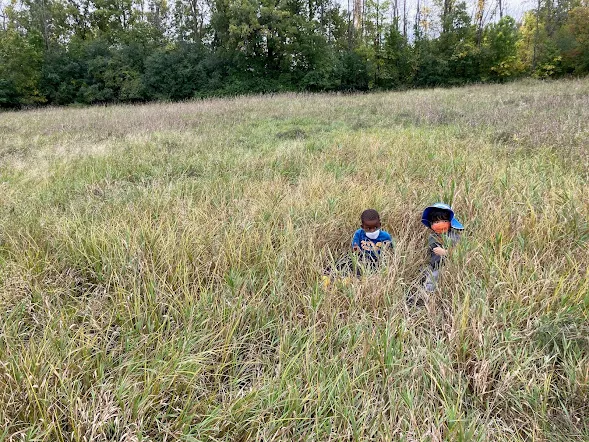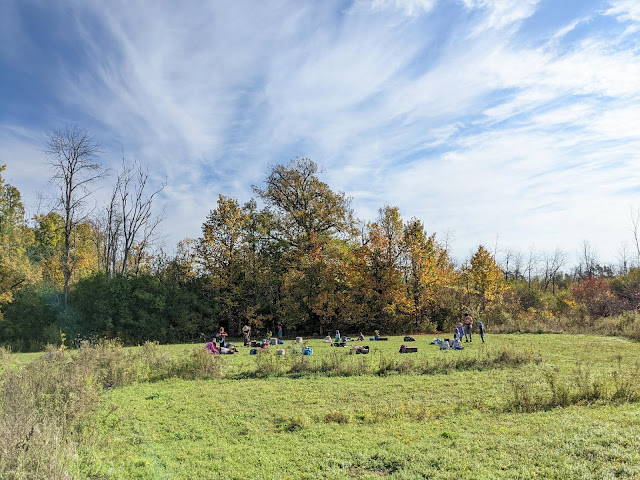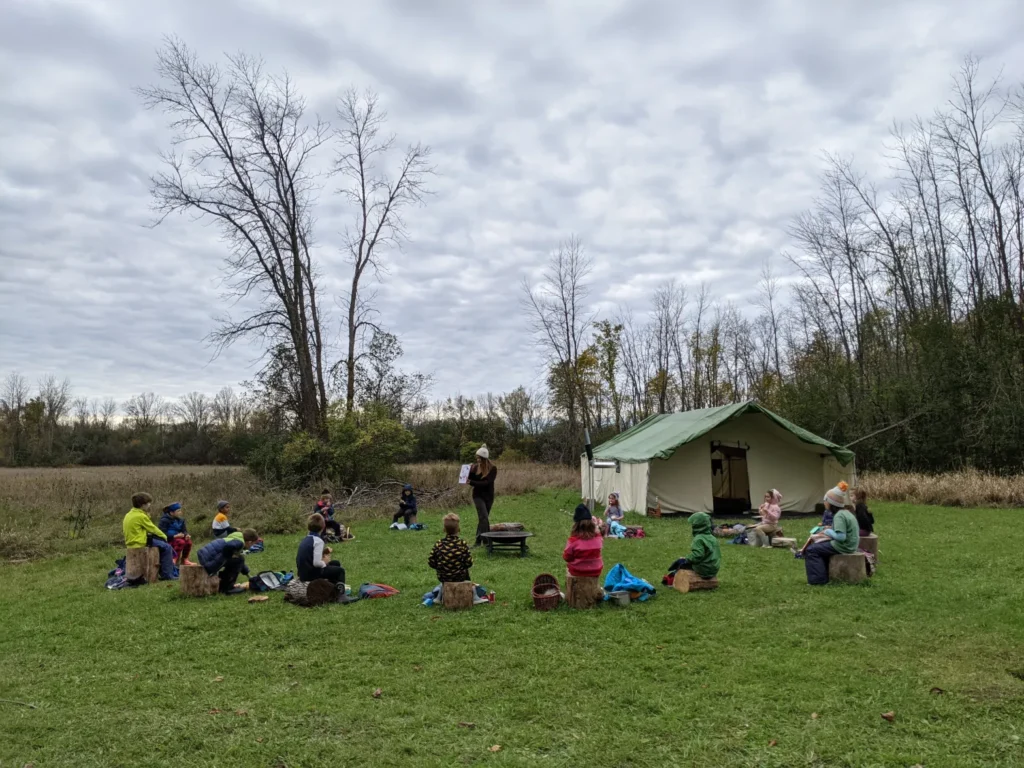We all understand the value of Stories. We have memories of being read to, of reading to our own children and those we work with. We have our favourite children’s books with engaging, poignant, funny stories and eye-catching, mesmerizing illustrations. We remember times when reading a story helped a sad child cheer up, or a rowdy group to calm down, or a shy child to feel comfortable and ready to play. There is a vast selection of storybooks available for every season, feeling, situation. Why is it necessary to practice telling Stories without books?
The simple answer is it isn’t necessary. If telling a story without a book feels insurmountable, it’s okay to settle into growing in other areas and relying on beautiful books to support your Forest and Nature School practice.
There is value, though, in being able to offer a Story to a group that comes from within, rather than reading one.

Why tell a Story rather than read it?
- Many cultural traditions, both on this land and from elsewhere around the world, are rooted in oral storytelling as a means of sharing teachings and of connecting to the past. We honour traditional Indigenous presence on this land by telling Stories.
- Telling a Story without illustrations offers each listener a chance to envision themselves in the Story in a way that books with illustrations cannot. We can choose main characters who reflect the audience, or leave the definition of who and how they are open so that a variety of listeners can relate to them.
- Telling a Story allows for the narrative and details to shift depending on dynamic factors such as the weather, the age and needs of the listeners, the season, previous experiences together, and more.
- The Story can take place right in the spot where you are telling it- it can be rooted in the land that the group is on and be full of details that make that clear and nurture that connection.
- It can offer the storyteller the chance to walk around the Circle while telling, and to make eye contact and be connected to the listeners differently than when everyone is focusing on a book.
- Reading stories is frequently modeled in a variety of environments. Oral storytelling offers another way of showing how stories can be told that can add to the listeners’ repertoire. (We often see storytelling emerge in children’s play, to each other and to forest creatures and to the forest itself. This is directly related to them having taken part in a Circle when a Story was told).

The land itself offers a Story every time we are out and about, Stories based in science and Stories filled with magic. They are often one and the same. Each human in a group brings their own Story to a place, from how their day has gone so far, to what experiences they recall from the last time they were playing on the land, to the Stories that flow and weave around them and their families.
Just about any time is the right time to tell a Story, and to make room for others to share their Stories. A lovely and nurturing principle of the Forest and Nature School approach is that there is time in the day- to sink in, to allow play to emerge naturally, and this allows much space for Story.
I know it can be intimidating to try to tell a Story. I’ve experienced many colleagues who eventually become comfortable storytelling to a group of children but who freeze up as soon as another adult is around. Whether it’s a harkening back to public-speaking experiences, shyness about sharing a Story that is one’s own creation, or nervousness about forgetting what to say next, many people who regularly address groups of children and adults find it challenging to tell Stories.
Interestingly, I’ve also noticed that when I tell a Story to a group that includes adults, they are easily as enthralled and engaged as the children are.
When to Tell a Story
There are some anchor points in the daily rhythm when it especially makes sense to tell a Story. These include:
- At the start of the day: as a ritual, to provide invitations or lessons for the day, to tie the play to previous weeks, to the land and to the season
- At snack time/lunchtime: to help children be still and focused, to provide inspiration for the afternoon without needing to have another transition after lunch, to tie the morning into the afternoon, to help children feel like they are a part of the story by including their adventures from the morning.
- At the end of the day: to tie into the morning Story, remember earlier experiences, to lead into Closing/Sharing Circle
- To prepare for and support Sit Spots: telling a story of when Owl, for example, lay still in the snow or leaned back against a tree, silently listening to and watching the forest around them, and then inviting the children to do the same.
- At stopping points on a hike: to hold the attention of the group while waiting for slower walkers to catch up

Storytelling Supports
With practice, I’ve learned some tips that I rely on when I’m telling Stories to groups. I find them very helpful to keep me on track and feeling ready, while also quite relaxed and able to engage with the group. You may also find these helpful when you are stretching your storytelling wings.
- Sometimes it makes sense to re-tell a story that I’ve learned from a book. I might stay very close to the original story, or I might modify it to our season or setting. I always acknowledge the original author, even if I’m more inspired by their writing to create a new story rather than actually re-telling theirs. (If I’m retelling a Story I’ve heard someone else tell, I mention that to the group. We all learn from and inspire each other all the time, let’s remember to celebrate and respect this truth by acknowledging each other!)
- If I want to share an Indigenous story, I must share by reading the book unless I have received permission to re-tell it. Being of settler origin and working with groups on this land it is essential that I honour Indigenous stories as they have been recorded and made available for audiences.
- Children are forgiving listeners. They’re usually grateful I’m sharing a story and they’re curious about what happens. They are my allies as the story unfolds.
- Distractions happen, and we carry on. I’ve experienced being asked to open snack containers while telling stories; I’ve had them interrupted to share completely unrelated information; I’ve even heard a child say to a friend in a very loud whisper, “This story is SO boring,” right in the middle of it! Many children will be engaged, some won’t be, and I smile (while laughing inside) and keep going.
- Having a predictable flow at the beginning and at the end builds rhythm and connection into the Stories. For example, stories with Poppa and Brother and Sister begin when the children get home from school, they take deep breaths to get into and out of their Magic World, and they always end with sitting down to supper with Poppa. It’s predictable and becomes comfortable, to the point where when we’ve asked the children what they predicted would happen in Story they were able to recount all of these elements.
- Stories can be very simple. When I’m telling stories to help folks sit still at lunchtime I often think back on my day. I can turn a sighting of a deer on my drive, or watching chickadees at my bird feeder, or seeing a nest that I thought was a porcupine, into suspenseful, riveting stories. We often laugh at the end of them, the children ask for them again, and they take turns telling their own simple stories.

- Changing my tone and cadence as I speak can help squirmy, chatty friends to listen more calmly. I make my voice big, then very small; I pause then have the words tumble over each other excitedly, though I do strive to remember to speak slowly and clearly enough that everyone can hear me.
- I make a rough plan of what happens in the story, envision the beginning, the middle, the end, think through some details, and then just trust that I’ll fill it in as we go. (I find this much easier now that I’ve had lots of practise.) This helps the story grow naturally while being told, leaves room for little surprises to enter in (like the flock of geese that honked their way overhead during an autumn Story), and also helps keep the story connected to an arc so that it does eventually end, hopefully in a way that resembles my original vision.
- I often weave the truth into the stories so that I can more easily remember the details. Characters are modelled after my own family members or friends, settings are familiar places, names might even be the same. The more familiar I am with these elements of the story the less I need to prepare them because I already know them. I can devote my creative energy to the magical goings-on in the story instead.
- The Big Stuff that happens in the story (the friends that Child meets, the places that appear on the Magical Map) I tend to share in groups of 3. That offers enough repetition that children can know what to expect and anticipate it (like in the 3 Bears story, for example) but also stay engaged because it isn’t too long and complicated.
- Transitioning to play- I’ll usually end a story with “And that’s the end of my story. I wonder if we will… hear the trees talking to us today? Or see any wild creatures today? Or see any puddles that we can explore today?” etc. I draw an open-ended and direct connection from the story to the play as an invitation.
Stories exist around us, swirling through our work and play every day. Oral storytelling is a traditional way of sharing teachings and inspiration on the land. It is a pleasure and honour to be able to share stories with children and families as often as I do. I wish you luck on your storytelling journey, whatever it looks like and wherever it takes you.

